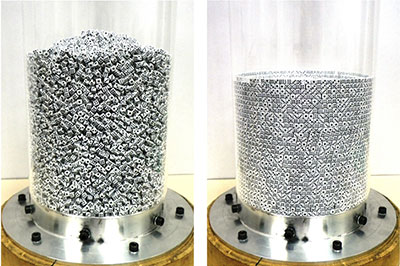
A new and rapid way to pack identical cubes in a dense configuration has been discovered by physicists in Spain and Mexico. Their work offers new insights into granular compaction and could lead to the development of new methods for producing dense granular systems both on Earth and in space.
The team, led by Diego Maza of the Universidad de Navarra, poured 25,000 small plastic dice into a clear cylindrical barrel of radius 8.7 cm (see figure). They then began twisting the barrel back and forth, rotating it clockwise then anticlockwise repeatedly about one cycle per second. The twisting action itself did not agitate the dice, but the jolt from changing direction did, inducing shear.
Edge effects
When they twisted the barrel slowly, dice at the edges tended to align but the central region remained disordered. At this rate, they calculated that it would take 10 years of twisting to attain perfect packing; a state where the dice lie in horizontal layers and in nearly perfectly ordered concentric rings within each layer.
However, when they increased the twist acceleration above 0.52g, the alignment process also accelerated. Indeed, after 10,000 twists the dice were packed together in a perfect pattern. “Dice inertia and boundary interaction combine to drive the system to a highly-ordered state, with the number of arranged particles in each layer near its maximum,” says Maza. “This limit represents a complex mathematical problem, which is not yet solved.”
Interestingly, the team experimented with more and fewer dice, revealing that the heavier load of more dice competes with the shear process to prevent the dice from densely packing together. Meanwhile, a small number of dice requires far less acceleration to become aligned rapidly. They also explored different accelerations, finding that the higher the acceleration, the quicker the system reached a highly-ordered state.
Different state of matter
On the face of it, a barrel of dice seems to be a simple system. Each die is regular and interacts via direct contact with its neighbouring dice. Yet a granular material like this behaves neither as a solid, liquid nor gas. Indeed, granular materials could be regarded as an additional state of matter.
Understanding and optimizing the dynamics of how granular materials pack together remains an open challenge. And with materials like grain, sand, ores, pharmaceuticals and many more needing to be packed tightly together to minimize the volume of their container in myriad industries, solving this problem is an economic priority.
The conventional packing technique used for everything from packing powders in the pharmaceutical industry to compacting soil for highways consists of repeatedly tapping the material. By first tapping at high intensities and then reducing the intensity, grains can be packed densely. Yet this process is slow and involves large accelerations.
Lower accelerations
“Although this technique is undoubtedly useful, it might not always be the most energetically efficient process,” adds Maza. In contrast, the new twist technique requires less intense acceleration and allows the dice to rapidly achieve maximum order.
“We don’t need an external force field such as gravity to compact the particles,”
Diego Maza, Universidad de Navarra
Importantly, the twisting method works based solely on the interaction of the dice – unlike tapping, twisting induces local disturbances that propagate through the system to compact it. “So we don’t need an external force field such as gravity to compact the particles,” adds Maza. This result suggests the twist technique could be used to pack granular materials in low-gravity environments like the International Space Station, where the conventional tapping technique does not work.
Moreover, twisting dice may prove useful in the study of the interplay between entropy and particle shapes. “Most surprising is that the final density may be the densest possible, ordered, and not with any random close packing,” says Jérôme Crassous, a granular physics expert from the Université de Rennes 1 in France. “A natural emerging question is: is it possible to do the same with other objects, like spheres?”
The research is described in Physical Review Letters.



